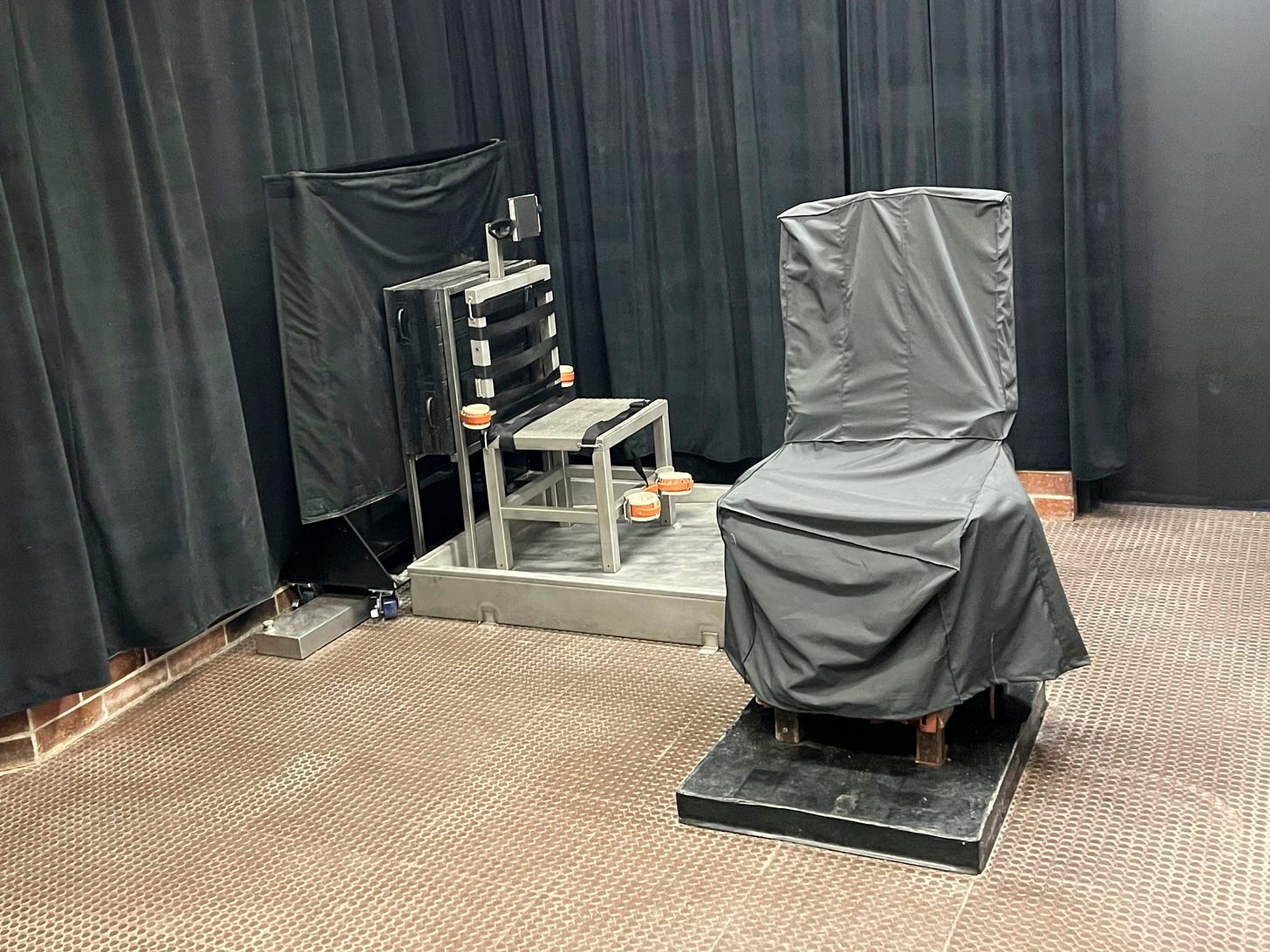Dead set on killing
South Carolina’s most powerful politicians would strike back-alley deals for lethal injection drugs

South Carolina’s lawmakers have been hyper-fixated on killing this year. A teenager with an identical list of obsessions would be called into the school guidance counselor’s office for a threat assessment.
In one chamber of our state legislature, members of the House Judiciary Committee have been mulling a bill that would make people who obtain an abortion eligible for murder charges and the death penalty.
In the other chamber, the Senate passed a bill on Feb. 22 that would shield the identity of lethal injection drug providers. This is a creative workaround to re-up the state’s supply of lethal drugs, which have recently become impossible to buy via the open market.
Taken together with our current death-penalty regime, the two bills (the anti-abortion House Bill 3549, which remains in committee, and the pro-execution Senate Bill 120, which was read in the House yesterday) would authorize agents of the state to arrest people who terminate their pregnancies; charge and prosecute them for murder; cage them on death row in Columbia; and kill them either by shooting them through the chest, electrocuting them in a wooden chair, or poisoning them with a proprietary drug cocktail.
The dead-eyed resolve of our state’s leading lights was on full display Feb. 22 as Sen. Greg Hembree (R-North Myrtle Beach), a former prosecutor, pushed through the “shield law” for lethal injections in a 39-5 vote. As currently written, the bill would exempt the purchase of lethal-injection drugs, supplies, and equipment from the South Carolina Procurement Code, effectively meaning that the state could buy these products in secret, hide the ingredient list from the public, and never disclose the identity of the seller or compounding pharmacy even in the event of a botched execution.
Hembree bracketed off the morality of state killing and kept the debate focused on mere logistics, as he and his esteemed colleagues have done since South Carolina’s last batch of lethal drugs went bad in 2013.
“It’s not whether we have the death penalty or not — that’s another issue for another day perhaps — but this is simply: Should the condemned have the option to choose lethal injection as a method of execution?” Hembree said.
Politicians of both parties have been trying to pass a shield law since at least 2017, when Gov. Henry McMaster lamented that the state lacked the capacity to kill Bobby Wayne Stone, a mentally disabled man who shot and killed a sheriff’s deputy.
“Anytime we start the conversation with a company that makes the drugs … they ask, how would they be protected?” Department of Corrections Director Bryan Stirling told reporters in 2017.
By Hembree’s count, 14 states with capital punishment laws have passed “shield laws,” with varying levels of success in practice. His concern, on the floor of the Senate last week, was that we stitch up the particulars so we can resume the business of killing the 35 men on Death Row.

Sen. Margie Bright Matthews (D-Colleton) tried quizzing Hembree on how other states with similar “shield laws” had fared in recent years. To his credit, Hembree half-remembered the story out of Texas (he said it was Arizona), where state officials went searching on the black market and nearly bought lethal injection drugs from a group of entrepreneurs who also sold Xanax and Ritalin to partiers out of a shopping mall in Gujarat, India. (Arizona, meanwhile, has been trying to execute prisoners with Zyklon B, the chemical preferred by the Third Reich for its gas chambers.)
The identity of lethal injection drug sellers isn’t the only secret our lawmakers are willing to keep. The identities of firing squad members are confidential, and the state Department of Corrections has refused to give any details about the provenance and maintenance of its electric chair, which likely still has components built by an amateur electrician nicknamed “Mr. Death.”
Prison directors and politicians have been experimenting on death row inmates since their supplies of the usual lethal drugs ran dry. In a report for the Death Penalty Information Center in 2018, attorney Robin Konrad found:
Lethal injection was supposed to be a more humane method of execution than hanging, the firing squad, or the electric chair, but there have been frequent reports of prisoners who were still awake and apparently experiencing suffocation and excruciating pain after they were supposed to be insensate. These problems have intensified with the use of new drug formulas, often including midazolam.1
The infamous 2014 botched execution of Dennis McGuire in Ohio, carried out with an experimental mix of midazolam and hydromorphone, was so gruesome that the state stopped killing for three years. In 2022 the state of Alabama carried out a series of botched and failed executions that saw executioners slashing and stabbing the arms of imprisoned men as they failed to find veins for IV lines. Alabama’s three-hour execution of Joe Nathan James Jr. in 2022 for the murder of Faith Hall, which was carried out against the wishes of Hall’s family, was the longest botched execution in the history of lethal injections.
“I don’t buy for a second the narrative being pushed by activists that these issues are the fault of the folks at Corrections or anyone in law enforcement, for that matter. I believe that legal tactics and criminals hijacking the system are at play here,” said Alabama Gov. Kay Ivey, in reference to the horrific run of botched and failed killings under her watch.
We find ourselves in an era of death chamber entrepreneurialism largely because, around 2009, pharmaceutical companies began refusing to sell traditional lethal-injection drugs like sodium thiopental, pancuronium bromide, and potassium chloride to U.S. correctional departments. Conservatives on the Supreme Court have blamed “activists” engaged in a “guerrilla war against the death penalty” (Glossip v. Gross, 2015 — thanks for making us sound cool, Sam Alito), but the reality is a little less exciting.
Law Professor Eric Berger wrote in 20202 about “the surprising effectiveness of uncoordinated actors” in cutting off state access to lethal drugs. With public approval of the death penalty at an all-time low, the U.S. is one of just 55 countries that still kills its own citizens as punishment, and one of a vanishingly small minority among developed Western countries. Many European governments forbid pharmaceutical companies that do business in their countries from selling drugs that could be used in U.S. death chambers. So the pharmaceutical companies stopped selling poison to U.S. prison wardens for business reasons, not moral ones.
“Pharmaceutical corporations, institutional investors, doctors, nurses, medical associations, capital lawyers, foreign governments, federal drug regulators, reporters, academics, and others — including, yes, abolitionist activists — all play a part,” Berger wrote.
In a strange twist of fate, the Supreme Court of South Carolina rather than of the United States is currently standing in the way of South Carolina lawmakers’ most draconian measures from the past year: a near-total abortion ban and a plan to execute imprisoned men by firing squad or electric chair. On the matter of the abortion ban, the court ruled that the law was an obvious violation of the right to privacy in the state constitution. On the execution front, the court is demanding more information from the state Department of Corrections on its attempts to buy lethal injection drugs. The courts have questions about the state’s other methods, too.
“[T]here is no scientific or medical justification for the way South Carolina carries out judicial electrocutions,” Fifth Circuit Judge Jocelyn Newman wrote on Sept. 6 in an order halting the executions. As I wrote at the time, Judge Newman’s order, which draws on testimony from a 4-day trial in August, exposes how much of the state’s killing protocol is based on conjecture, tradition, and amateur research.
Watching the state Senate lightly debate the shield law last week, I didn’t hear anyone speak the names of the men they were trying to kill. The first man to be killed in the newly equipped death chamber would likely be Richard Moore, who has been living on Death Row since 2001.
Moore’s case is a textbook example of the arbitrariness of the death penalty, which has been applied disproportionately to Black perpetrators and those with white victims. Around 3 a.m. on Sept. 16, 1999, according to The Post and Courier, Moore walked unarmed into Nikki’s Speedy Mart in rural Spartanburg County. For reasons that remain unclear, the clerk working that night, James Joseph Mahoney III, grabbed one of the three guns he kept at the register.
The two men got into a struggle over the gun, and both ended up shooting one another. Mahoney died. Moore survived and, in a fateful decision, grabbed a bag of cash from behind the register. He surrendered to a sheriff’s deputy hours later after fleeing to a drug dealer’s house and then trying to drive himself to the hospital.
Last spring, after decades of legal and technical delays and with lethal injection still off the table, the state forced Moore to choose between a firing squad and an electric chair.
“Both ways that the state presented to me are barbaric,” Moore told The Post and Courier in a rare death row interview. “How do you choose one evil over the next?”
Now the firing squad and electric chair are on hold, and Sen. Hembree and his colleagues are working hard to put a third evil on the table again.

***
Brutal South is a free weekly newsletter about class struggle and education in the American South. If you would like to support my work and get access to the complete archive of subscriber-only stuff, paid subscriptions are $5 a month.
Bookshop // Twitter // Bandcamp // Spotify Podcasts // Apple Podcasts
Robin Konrad, Behind the Curtain: Secrecy and the Death Penalty int he United States, Death Penalty Information Center (2018), https://deathpenaltyinfo.org/facts-and-research/dpic-reports/in-depth/behind-the-curtain-secrecy-and-the-death-penalty-in-the-united-states
Eric Berger, Courts, Culture, and the Lethal Injection Stalemate, 62 Wm. & Mary L. Rev. 1 (2020), https://scholarship.law.wm.edu/wmlr/vol62/iss1/2



